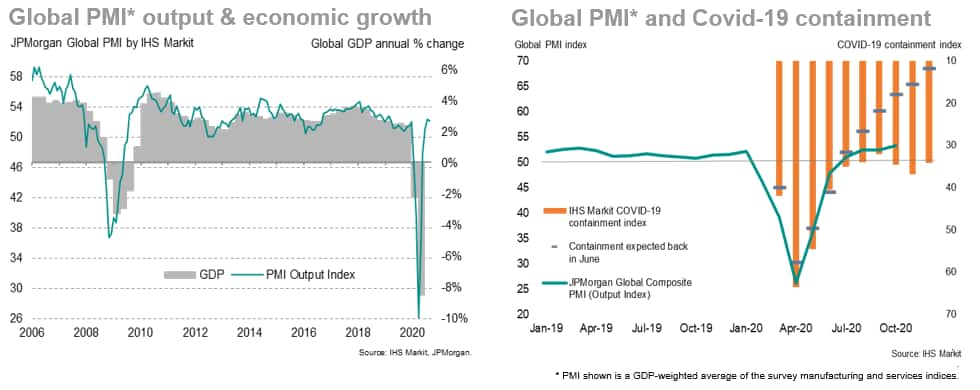Global growth accelerates in October but divergences widen as COVID-19 numbers rise
The following is an extract from IHS Markit's monthly PMI overview presentation. For the full report please click on the link at the bottom of the article.
The worldwide PMI surveys indicated a solid start to Q4 for the global economy, with business activity rising at the fastest rate for 26 months. The headline JPMorgan Global PMI™ (compiled by IHS Markit) to 53.3 in October, its highest since August 2018.
The PMI has improved since Q2 as economies have opened up after lockdowns designed to curb the spread of COVID-19. But reintroduced measures in some countries due to second waves of infections have subdued the pace of recovery. The global average COVID-19 Containment Index eased from a peak of 64 in April to 32 in September, but has since risen again to 35 in October, representing a significant and tightening degree of containment. The degree of containment has also remained far higher than had been expected just a few months ago, reflecting the scale of resurgent infection numbers in many countries. These measures have tightened further in November, suggesting downward pressure on the PMI.
Chris Williamson, Chief Business Economist, IHS Markit
Tel: +44 207 260 2329
chris.williamson@ihsmarkit.com
© 2020, IHS Markit Inc. All rights reserved. Reproduction in whole
or in part without permission is prohibited.
Purchasing Managers' Index™ (PMI™) data are compiled by IHS Markit for more than 40 economies worldwide. The monthly data are derived from surveys of senior executives at private sector companies, and are available only via subscription. The PMI dataset features a headline number, which indicates the overall health of an economy, and sub-indices, which provide insights into other key economic drivers such as GDP, inflation, exports, capacity utilization, employment and inventories. The PMI data are used by financial and corporate professionals to better understand where economies and markets are headed, and to uncover opportunities.
This article was published by S&P Global Market Intelligence and not by S&P Global Ratings, which is a separately managed division of S&P Global.

